Difference between revisions of "Avatar"
Phoenician (talk | contribs) (keeping sections consistent with Production Background after Real World Background on pages that have both.) |
|||
| (One intermediate revision by the same user not shown) | |||
| Line 1: | Line 1: | ||
[[Image:Anubis_Jackal.png|thumb|360px|Jackal as Anubis's Avatar.]] | [[Image:Anubis_Jackal.png|thumb|360px|Jackal as Anubis's Avatar.]] | ||
| − | [[Image:Anubis_Emir.png|thumb| | + | [[Image:Anubis_Emir.png|thumb|250px|The Emir as Anubis's Avatar.]] |
'''Avatar''' is a term used for a mortal who is merged with a [[Children of Oberon|Child of Oberon]] through [[magic]]. | '''Avatar''' is a term used for a mortal who is merged with a [[Children of Oberon|Child of Oberon]] through [[magic]]. | ||
The mortal in question becomes more like that Child of Oberon in appearance, and is also freely able to use the powers of that being. {{CIT|Only one person can be an avatar of a given Child of Oberon at any one time.}} [http://www.s8.org/gargoyles/askgreg/search.php?qid=9732] | The mortal in question becomes more like that Child of Oberon in appearance, and is also freely able to use the powers of that being. {{CIT|Only one person can be an avatar of a given Child of Oberon at any one time.}} [http://www.s8.org/gargoyles/askgreg/search.php?qid=9732] | ||
| − | + | __TOC__ | |
| + | <br style="clear:both;"/> | ||
==History== | ==History== | ||
One known instance of such an event was when first [[Jackal]], and then the [[Emir]], became the avatar of [[Anubis]] through the magic of the [[Scroll of Thoth|Scroll]] of [[Thoth]]. Both [[human]]s developed a jackal's head and gained the full use of Anubis's powers; when they spoke, Anubis's voice could even be heard in the background, repeating the same words. In both cases, the human who had become avatar was in command, with Anubis presumably being dormant. ''([[Grief|"Grief"]])'' | One known instance of such an event was when first [[Jackal]], and then the [[Emir]], became the avatar of [[Anubis]] through the magic of the [[Scroll of Thoth|Scroll]] of [[Thoth]]. Both [[human]]s developed a jackal's head and gained the full use of Anubis's powers; when they spoke, Anubis's voice could even be heard in the background, repeating the same words. In both cases, the human who had become avatar was in command, with Anubis presumably being dormant. ''([[Grief|"Grief"]])'' | ||
Latest revision as of 12:09, 25 February 2025
Avatar is a term used for a mortal who is merged with a Child of Oberon through magic.
The mortal in question becomes more like that Child of Oberon in appearance, and is also freely able to use the powers of that being. Only one person can be an avatar of a given Child of Oberon at any one time. [1]
History
One known instance of such an event was when first Jackal, and then the Emir, became the avatar of Anubis through the magic of the Scroll of Thoth. Both humans developed a jackal's head and gained the full use of Anubis's powers; when they spoke, Anubis's voice could even be heard in the background, repeating the same words. In both cases, the human who had become avatar was in command, with Anubis presumably being dormant. ("Grief")
Because of his close physical proximity to Odin himself, Goliath also became a quasi-avatar of Odin after donning the Eye of Odin in Norway. ("Eye of the Storm") [2][3]
Real World Background
In Hinduism, avatars are the manifestations or forms of deities. Most often, the word is used of the ten earthly manifestations of the Supreme Being Vishnu, which include Krishna, Gautama Buddha, and Rama. Each of the ten avatars was, or is, an individual deity, animal, or human being. Vishnu, Shiva, and Brahma (the Trimurti) can also be described as avatars or forms of the Supreme Being. At times major religious leaders, of Hinduism and even of other religions, have also been considered avatars of various deities.
The gods sometimes did form connections with individual mortals in ancient Egyptian religion, especially with the living Pharaoh. Funerary texts also contain spells which were supposed to allow the deceased to transform into one of the gods, such as Osiris.
The Egyptian gods were more often depicted as connecting with one-another. A combination of two deities was named by hyphenating the names of the two gods, and usually their appearances were also mixed together in the composite image, much like the avatars in Gargoyles. These merged beings include such famous deities as Amon-Re and Re-Horakhty. When two gods were connected in this way, they were not believed to permanently merge or become the same god, but were described as "resting within" each other. The two deities were still regarded as separate, individual beings.
Almost all such combinations in Egyptian religion involved two deities of different rank. The lesser deity increased in power when he or she was merged with another god, while the greater deity gained power within the lesser god's sphere of influence. Occasionally, three or even four gods could be joined in this way. Such combinations could explain situations in which one deity took on a role or attributes usually belonging to another. Priests of local or minor gods sometimes used combined images and names to promote the cult of their god, by linking her or him to a greater deity.
Production Background
Greg Weisman came up with the idea of blending the voices of Anubis and whoever was his avatar in post-production as a bit of "accidental brilliance". [4][5] He's since been fond enough of the vocal effect to include it in both The Spectacular Spider-Man and Young Justice. [6][7]
See Also
- Avatar at Wikipedia, the Free Encyclopedia

